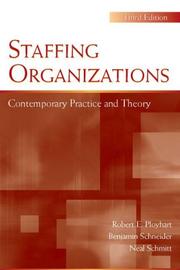Check nearby libraries
Buy this book

This edition doesn't have a description yet. Can you add one?
Check nearby libraries
Buy this book

Previews available in: English
Subjects
Employees, Recruiting, Personnel & human resources management, Human Resources & Personnel Management, Business / Economics / Finance, Business & Economics, Business/Economics, Business & Economics / Human Resources & Personnel Management, Employees, recruiting, Personnel, Recrutement, BUSINESS & ECONOMICS, Industrial Management, Management, Management Science, Organizational BehaviorShowing 3 featured editions. View all 3 editions?
| Edition | Availability |
|---|---|
|
1
Staffing organizations: contemporary practice and theory
2006, Lawrence Erlbaum Associates, Publishers, Lawrence Erlbaum Associates
in English
- 3rd ed.
0805855793 9780805855791
|
aaaa
Libraries near you:
WorldCat
|
|
2
Staffing Organizations: Contemporary Practice and Theory, Third Edition (Applied Psychology)
November 30, 2005, Lawrence Erlbaum Associates
Paperback
in English
- 3 edition
0805855807 9780805855807
|
zzzz
Libraries near you:
WorldCat
|
|
3
Staffing Organizations: Contemporary Practice and Theory, Third Edition (Applied Psychology)
November 30, 2005, Lawrence Erlbaum Associates
Hardcover
in English
- 3 edition
0805855793 9780805855791
|
zzzz
Libraries near you:
WorldCat
|
Book Details
Table of Contents
Aims of the chapter
Staffing organizations defined
A focus on the changing nature of work
A focus on individual differences
A focus on the work and work environment
A focus on how staffing contributes to organizational effectiveness
A focus on the influence of federal employment legislation and court cases
Summary
Measurement concepts and data analytic tools
Background
Aims of the chapter
Nature of measurement
Manifest and latent variables
Summarizing measurements of individual differences
Covariation
The Pearson product-moment correlation coefficient (r)
Predictions based on correlation
Predictions using multiple predictors
Reliability
Validity
Moderated regression
Structural equation modeling
Hierarchical linear modeling
Item response theory
Summary
Job analysis
Aims of the chapter
Job analysis is the foundation of staffing
The larger environment
Historical perspectives on job analysis
Modern perspectives on jobs and job specifications
Current challenges for job analysis
Summary
Performance and criterion development
Aims of the chapter
The importance of organizational context and goals
Criteria defined
Models of the job performance domain
Desirable aspects of criteria
Objective criterion measures
Judgmental criterion measures
A comparison of objective and judgmental criteria
Criterion measurement considerations
Current challenges for performance and criterion development
Summary
Recruitment: retention and attraction
Aims of the chapter
Internal recruitment
External recruitment
Current challenges for internal and external recruitment
Summary
Validation strategies and utility
Aims of the chapter
Approaches to validation
Validity based on test content
Validity based on the theoretical meaningfulness of tests
Validity based on the consequences of testing
Test utility
Summary
Hiring procedures: an overview
Aims of the chapter
Predictors: a general definition
A model of the predictor-response process
The structure and function of the predictor domain
Evaluating the adequacy of predictors
Use of predictors in staffing practice
Current issues in predictor development
Summary
Hiring procedures I: cognitive ability and certification exams
Aims of the chapter
Paper-and-pencil tests of general ability
Racial subgroup differences and cognitive ability
Licensure and certification exams
Summary
Hiring procedures II: personality tests
Affective measures, interests, and biodata
Aims of the chapter
Personality and personality tests
Interests and interest testing
Biographical data
Summary
Hiring procedures III: interviews, performance-based tests, simulations, and physical ability
Aims of the chapter
Interviews
Performance-based and simulation testing
Physical ability testing
Summary
The practice of staffing: legal, professional, and ethical concerns
Aims of the chapter
A tripartite view of staffing practice
Legal issues
Professional standards
Ethical considerations
Current issues in staffing practice
Summary
Staffing organizations: review and implications
Aims of the chapter
Effective staffing: emphasizing some key points
Recommendations for practical staffing problems
Speculation on the future innovations in staffing
Implications for the job seeker.
Edition Notes
Includes bibliographical references and index.
Previous edition: Glenview, Ill.: Scott, Foresman, 1986; lists Benjamin Schneider as first author.
Classifications
External Links
The Physical Object
ID Numbers
Community Reviews (0)
Feedback?History
- Created April 1, 2008
- 17 revisions
Wikipedia citation
×CloseCopy and paste this code into your Wikipedia page. Need help?
| March 7, 2023 | Edited by MARC Bot | import existing book |
| February 28, 2023 | Edited by ImportBot | import existing book |
| February 28, 2023 | Edited by ImportBot | import existing book |
| February 9, 2023 | Edited by BWBImportBot | Modified local IDs, source records |
| April 1, 2008 | Created by an anonymous user | Imported from Scriblio MARC record |











